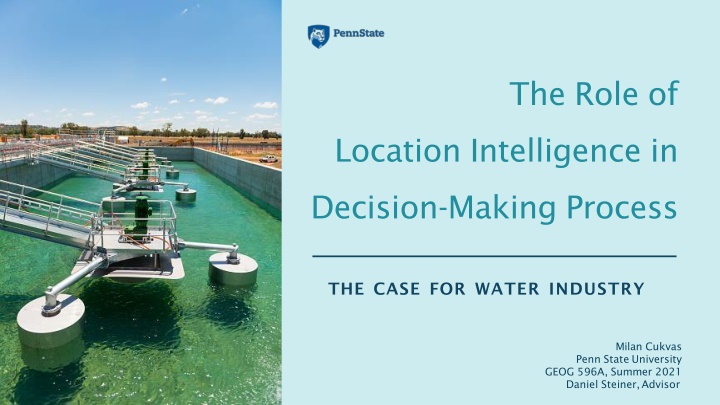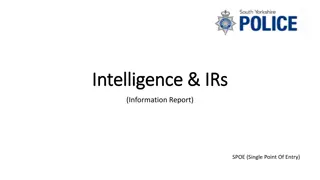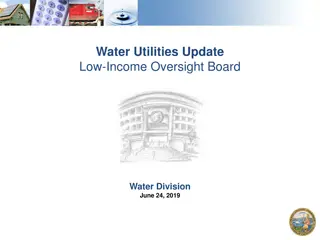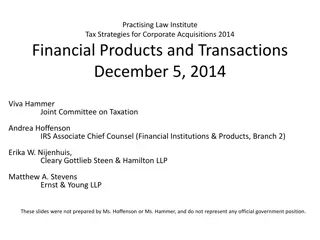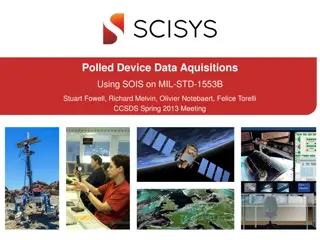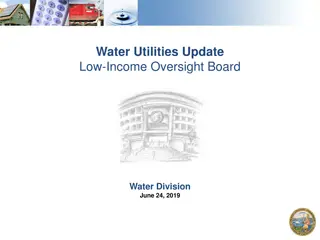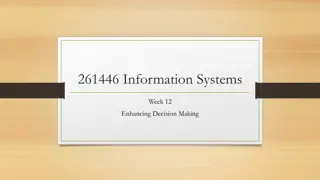Enhancing Decision-Making with Location Intelligence in Water Industry Acquisitions
Delve into the pivotal role of location intelligence in the decision-making process for water industry acquisitions. Discover how accurate prediction of investment outcomes is achieved through the integration of environmental, geographic, census, and financial data. Explore the significance of data deduction and the impact on acquisition success.
Uploaded on Sep 13, 2024 | 1 Views
Download Presentation

Please find below an Image/Link to download the presentation.
The content on the website is provided AS IS for your information and personal use only. It may not be sold, licensed, or shared on other websites without obtaining consent from the author.If you encounter any issues during the download, it is possible that the publisher has removed the file from their server.
You are allowed to download the files provided on this website for personal or commercial use, subject to the condition that they are used lawfully. All files are the property of their respective owners.
The content on the website is provided AS IS for your information and personal use only. It may not be sold, licensed, or shared on other websites without obtaining consent from the author.
E N D
Presentation Transcript
The Role of Location Intelligence in Decision-Making Process THE CASE FOR WATER INDUSTRY Milan Cukvas Penn State University GEOG 596A, Summer 2021 Daniel Steiner,Advisor
Introduction Project Objective Research Methods Challenges and Limitation References Questions
Introduction Personal Background Milan Cukvas, Downers Grove, IL 2011 2013 Penn State GIS Certification Program 2013 2021 Penn State GIS Master Studies Program 30 Years of Experience in Water and Wastewater Industry Since 2019 GIS Manager at American Water
Introduction Project Background Due to the insufficient amount of sensitive data available at the time of purchase, acquiring aging water and wastewater infrastructure can be challenging. Old, outdated, and poorly managed system Financial Information Lack of crucial technical background data Number of connections customers Number of assets Customer address data Total length of the system Earning Per Share value EPS The overall state of the system Rule of thumb data Accurate description of system s geometry Asset location, etc.
Introduction Project Hypothesis Hypothesis Location Intelligence plays a significant role in acquisition decision-making process, allowing for accurate prediction of the investment outcome based on available environmental, geographic, census, and financial data for the examined region! Utility as a part of the larger geographic region (locality and human-derived characteristics) allows for data deduction. Integration of geographic and financial data (Location Intelligence).
Introduction Terminology Location Intelligence the information repository for all available information Water Utility refers to both water and wastewater systems Integrated Geography refers to both physical and human geography Service Area the area encompassing the utility system
Informed decision-making Condition Interrelation between location of the utility and service areas Community profile (people movement trends) Climate tendencies To devise and test the validity of Environmental sustainability the method that would take number of factors in consideration, test them against End goal predetermined set of Current state assessment requirements, and express the Future investment prediction results in an easy-to-understand scorecard that would determine if potential acquisition is worthwhile or not. Intent List of requirements.
Project Objective Prerequisites Pre-requirement Criteria Optimum distance 25 mi Age of the utility <50 years Average income per capita in municipality > county average Owned and occupied housing units > rented/unoccupied Population increase in last 10 years positive Extreme weather incidents in 5-year span 1 Earnings Per Share (EPS) > estimated value
Data Assessment Re-Defining Data Conversion Prerequisites Methodological approach with elements of Explanatory Mostly Quantitative Method with some Qualitative elements Research Scope Proposed Research Steps Include (right): Data Presentation Method Validation
Research Method - Data Assessment andConversion Data Assessment Data Conversion Financial information such as EPS number https://illinoiscomptroller.gov/financial-data/local-government- division/local-government-data/searchform/?SearchType=AFRSearch Converting Qualitative into Quantitative Data Sets Caritas Segmentation Data: https://claritas360.claritas.com/mybestsegments/ Customer Connection Information http://water.epa.state.il.us/dww/index.jsp Population, Housing Information, Income per Capita https://www.census.gov/ and ESRI Business and Community App Community Standing, Community Profile, Spending Habits https://claritas360.claritas.com/mybestsegments/ Environmental Data https://www.noaa.gov/ Local Business Information ESRI Business Application Municipality Information Various municipality and county websites.
Research Method Scope and DataPresentation Research Scope Data Presentation Modify exiting prerequisite list if needed Favorable Investment: Score 2.3 - 3 based on findings in Data Assessment step Potential Loss: Score 1.7 2.3 Validate the prerequisites by verifying data Unfavorable Investment: Score below 1.7 availability for each. Scorecard Map Color Schema
Research Method ExpectedOutcomes & Validation To run this method against the acquisition that already happened before my involvement with the process! To confirm that my methodology is effective, by having all reviewed acquisitions scoring high! Or, in cases when acquisition was executed despite the results provided by my method showing low score, to review the system s financial stability since sale was closed.
References The History and Evolution of Water Utilities: 1. Adamides, E. D., et al. "A Multi-Methodological Approach to the Development of a Regional Solid Waste Management System." The Journal of the Operational Research Society, vol. 60, no. 6, 2009, pp. 758 770. JSTOR, www.jstor.org/stable/40206794. Accessed 5 June 2021. 2. Davenport, F. Garvin. "The Sanitation Revolution in Illinois 1870-1900." Journal of the Illinois State Historical Society (1908-1984), vol. 66, no. 3, 1973, pp. 306 326. JSTOR, www.jstor.org/stable/40190588. Accessed 5 June 2021. 3. N.d. Sanitary Sewer System. City of Champaign. http://champaignil.gov/wp- content/uploads/2008/08/c18-chapter-18-sanitary-sewer-standards.pdf The Climate and Water Utilities: 1. Fussell, Elizabeth, et al. "Weather-Related Hazards and Population Change: A Study of Hurricanes and Tropical Storms in the United States, 1980 2012." The Annals of the American Academy of Political and Social Science, vol. 669, 2017, pp. 146 167. JSTOR, www.jstor.org/stable/26361884. Accessed 5 June 2021. 2. 8. Rob Renner. "Climate Change, Extreme Weather, and Water Utilities: Preparing for the New Normal." Journal (American Water Works Association), vol. 105, no. 11, 2013, pp. 44 51. JSTOR, www.jstor.org/stable/jamewatworass.105.11.44. Accessed 5 June 2021.
References (Contd) Aggregation of Customer Data: 1. McGregor, Veronica K., et al. "Big Data and Consumer Financial Information." Business Law Today, 2013, pp. 1 4. JSTOR, www.jstor.org/stable/businesslawtoday.2013.11.05. Accessed 5 June 2021. The Financial Aspects of Acquisitions: 1. Addington Coppin, and Reed Neil Olsen. "Public vs. Private Sector Earnings Differentials in the Caribbean Region: Evidence from the Economy of Trinidad & Tobago." The Journal of Developing Areas, vol. 40, no. 2, 2007, pp. 51 74. JSTOR, www.jstor.org/stable/4193030. Accessed 5 June 2021. 2. Mary Ann Dickinson, et al. "Aligning Water Rates, Revenues, and Resources: Strategies for Today's Utility Managers." Journal (American Water Works Association), vol. 107, no. 2, 2015, pp. 52 59. JSTOR, www.jstor.org/stable/jamewatworass.107.2.52. Accessed 5 June 2021. 3. N.d. Investopedia. Earnings Per Share (EPS). https://www.investopedia.com/terms/e/eps.asp#:~:text=Earnings%20per%20share%20(EPS)%20 is,indicator%20of%20a%20company's%20profitability.&text=The%20higher%20a%20company's% 20EPS,it%20is%20considered%20to%20be.
Milan Cukvas mqc5324@psu.edu
